Attached files
| file | filename |
|---|---|
| EX-99.2 - EXHIBIT 99.2 - STATE STREET CORP | exhibit992-2q18earningsrel.htm |
| EX-99.1 - EXHIBIT 99.1 - STATE STREET CORP | exhibit991-2q18earningspre.htm |
| 8-K - 8-K - STATE STREET CORP | form8-k2q18.htm |

Exhibit 99.3 Second Quarter 2018 Financial Highlights July 20, 2018 (NYSE: STT)

Preface and forward-looking statements This presentation includes certain highlights of, and also material supplemental to, State Street Corporation’s news release announcing its second quarter 2018 financial results. That news release contains a more detailed discussion of many of the matters described in this presentation and is accompanied by detailed financial tables. This presentation is designed to be reviewed together with that news release, which is available on State Street’s website, at http://investors.statestreet.com, and is incorporated herein by reference. This presentation (and the conference call accompanying it) contains forward-looking statements as defined by United States securities laws. These statements are not guarantees of future performance, are inherently uncertain, are based on assumptions that are difficult to predict and have a number of risks and uncertainties. The forward-looking statements in this presentation speak only as of July 20, 2018, and State Street does not undertake efforts to revise forward- looking statements. See “Forward-looking statements” in the Appendix for more information, including a description of certain factors that could affect future results and outcomes. Certain financial information in this presentation is presented on both a GAAP and an adjusted (adjusted-GAAP) basis. Adjusted-GAAP basis presentations are non-GAAP presentations. Refer to the Appendix for explanations of our non-GAAP financial measures and to the Addendum for reconciliations of our non-GAAP financial information. 2
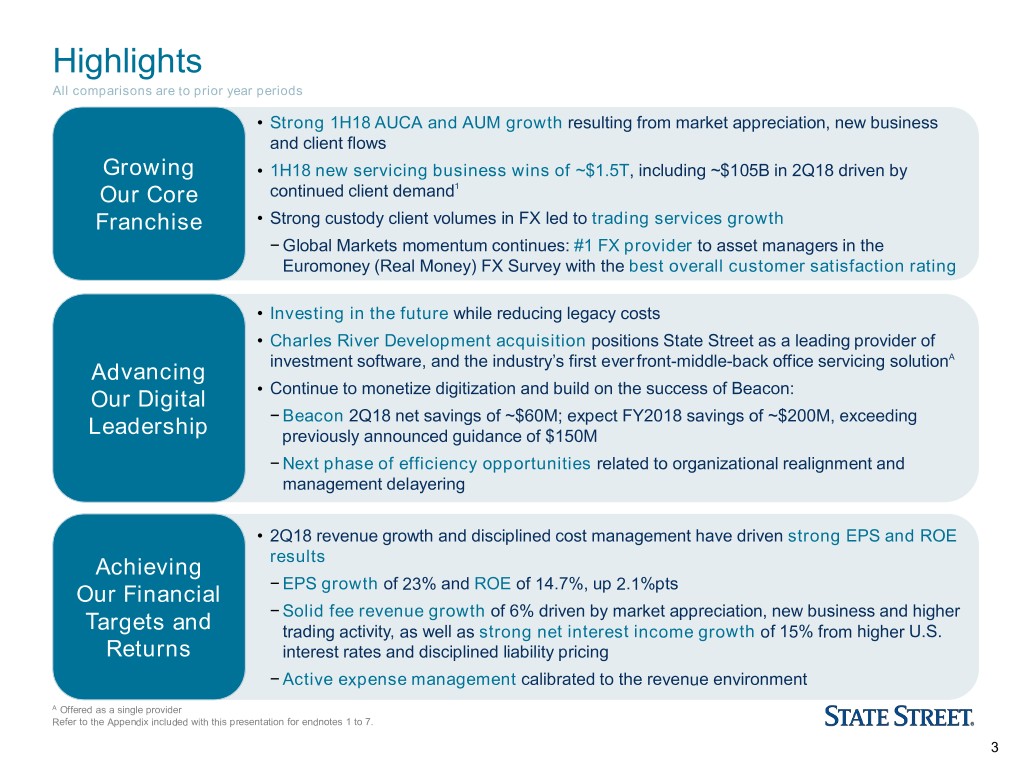
Highlights All comparisons are to prior year periods • Strong 1H18 AUCA and AUM growth resulting from market appreciation, new business and client flows Growing • 1H18 new servicing business wins of ~$1.5T, including ~$105B in 2Q18 driven by continued client demand1 Our Core • Strong custody client volumes in FX led to trading services growth Franchise − Global Markets momentum continues: #1 FX provider to asset managers in the Euromoney (Real Money) FX Survey with the best overall customer satisfaction rating • Investing in the future while reducing legacy costs • Charles River Development acquisition positions State Street as a leading provider of A investment software, and the industry’s first everfront-middle-back office servicing solution Advancing • Continue to monetize digitization and build on the success of Beacon: Our Digital − Beacon 2Q18 net savings of ~$60M; expect FY2018 savings of ~$200M, exceeding Leadership previously announced guidance of $150M − Next phase of efficiency opportunities related to organizational realignment and management delayering • 2Q18 revenue growth and disciplined cost management have driven strong EPS and ROE results Achieving − EPS growth of 23% and ROE of 14.7%, up 2.1%pts Our Financial − Solid fee revenue growth of 6% driven by market appreciation, new business and higher Targets and trading activity, as well as strong net interest income growth of 15% from higher U.S. Returns interest rates and disciplined liability pricing − Active expense management calibrated to the revenue environment A Offered as a single provider Refer to the Appendix included with this presentation for endnotes 1 to 7. 3
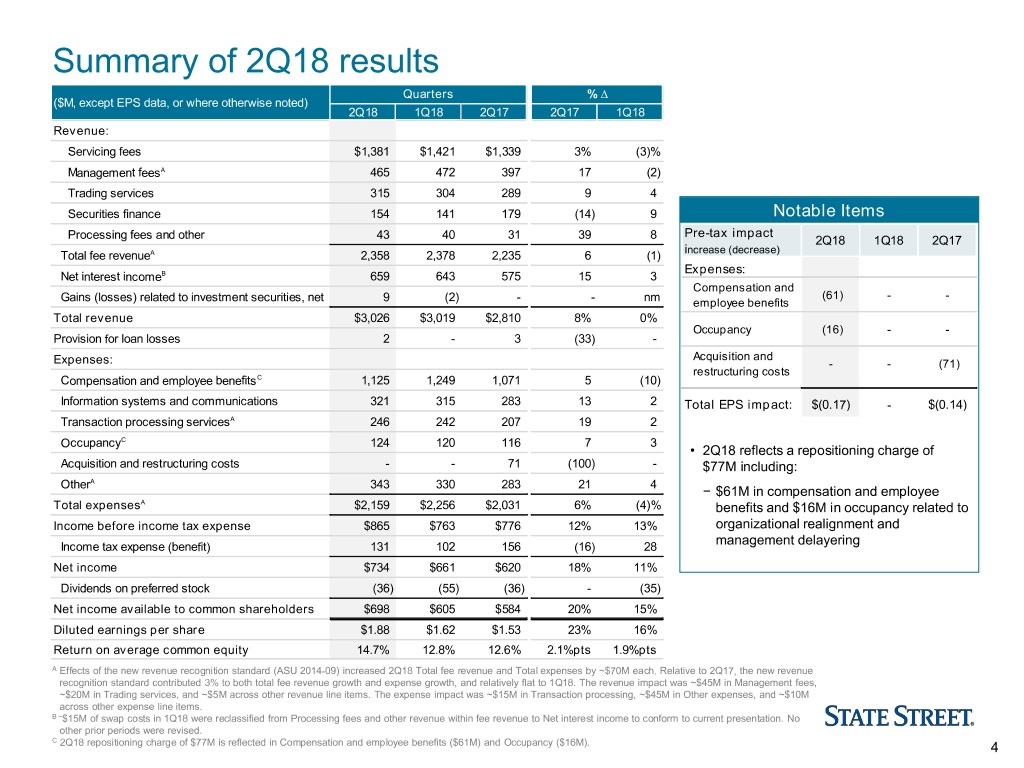
Summary of 2Q18 results Quarters % ∆ ($M, except EPS data, or where otherwise noted) 2Q18 1Q18 2Q17 2Q17 1Q18 Revenue: Servicing fees $1,381 $1,421 $1,339 3% (3)% Management feesA 465 472 397 17 (2) Trading services 315 304 289 9 4 Securities finance 154 141 179 (14) 9 Notable Items Processing fees and other 43 40 31 39 8 Pre-tax impact 2Q18 1Q18 2Q17 A increase (decrease) Total fee revenue 2,358 2,378 2,235 6 (1) B Expenses: Net interest income 659 643 575 15 3 Compensation and (61) - - Gains (losses) related to investment securities, net 9 (2) - - nm employee benefits Total revenue $3,026 $3,019 $2,810 8% 0% Occupancy (16) - - Provision for loan losses 2 - 3 (33) - Acquisition and Expenses: - - (71) restructuring costs Compensation and employee benefitsC 1,125 1,249 1,071 5 (10) Information systems and communications 321 315 283 13 2 Total EPS impact: $(0.17) - $(0.14) Transaction processing servicesA 246 242 207 19 2 OccupancyC 124 120 116 7 3 • 2Q18 reflects a repositioning charge of Acquisition and restructuring costs - - 71 (100) - $77M including: OtherA 343 330 283 21 4 − $61M in compensation and employee Total expensesA $2,159 $2,256 $2,031 6% (4)% benefits and $16M in occupancy related to Income before income tax expense $865 $763 $776 12% 13% organizational realignment and Income tax expense (benefit) 131 102 156 (16) 28 management delayering Net income $734 $661 $620 18% 11% Dividends on preferred stock (36) (55) (36) - (35) Net income available to common shareholders $698 $605 $584 20% 15% Diluted earnings per share $1.88 $1.62 $1.53 23% 16% Return on average common equity 14.7% 12.8% 12.6% 2.1%pts 1.9%pts A Effects of the new revenue recognition standard (ASU 2014-09) increased 2Q18 Total fee revenue and Total expenses by ~$70M each. Relative to 2Q17, the new revenue A recognition standard contributed 3% to both total fee revenue growth and expense growth, and relatively flat to 1Q18. The revenue impact was ~$45M in Management fees, A ~$20M in Trading services, and ~$5M across other revenue line items. The expense impact was ~$15M in Transaction processing, ~$45M in Other expenses, and ~$10M A across other expense line items. B ~$15M of swap costs in 1Q18 were reclassified from Processing fees and other revenue within fee revenue to Net interest income to conform to current presentation. No B other prior periods were revised. C 2Q18 repositioning charge of $77M is reflected in Compensation and employee benefits ($61M) and Occupancy ($16M). 4
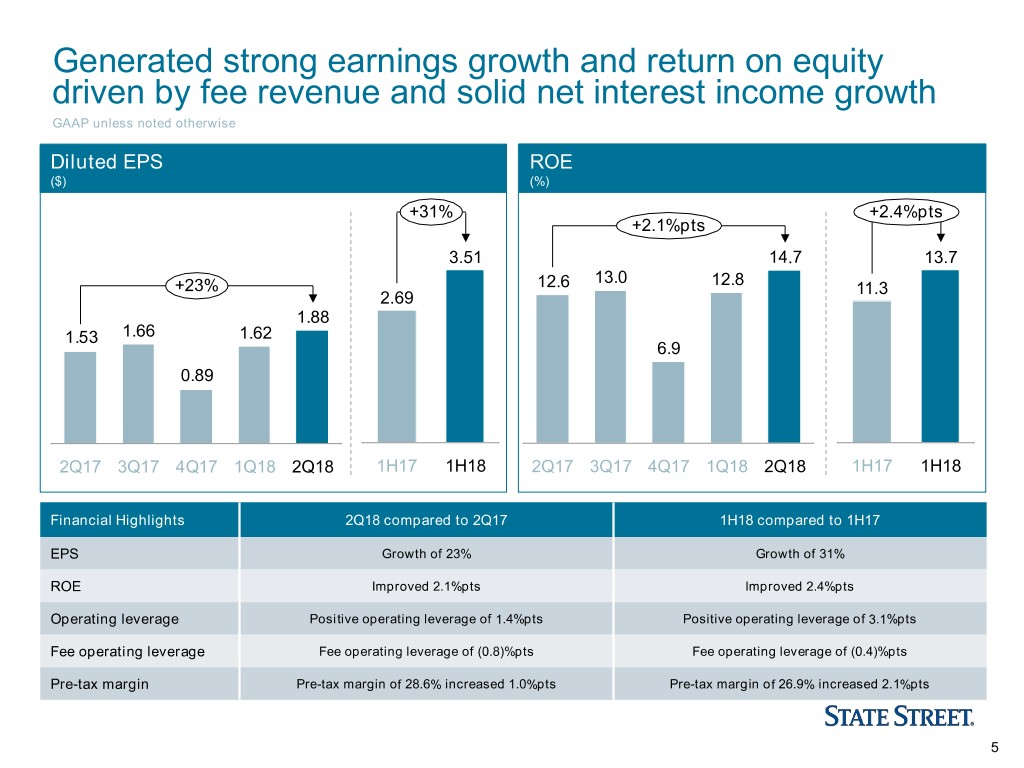
Generated strong earnings growth and return on equity driven by fee revenue and solid net interest income growth GAAP unless noted otherwise Diluted EPS ROE ($) (%) +31% +2.4%pts +2.1%pts 3.51 14.7 13.7 13.0 12.8 +23% 12.6 11.3 2.69 1.88 1.53 1.66 1.62 6.9 0.89 2Q17 3Q17 4Q17 1Q18 2Q18 1H17 1H18 2Q17 3Q17 4Q17 1Q18 2Q18 1H17 1H18 Financial Highlights 2Q18 compared to 2Q17 1H18 compared to 1H17 EPS Growth of 23% Growth of 31% ROE Improved 2.1%pts Improved 2.4%pts Operating leverage Positive operating leverage of 1.4%pts Positive operating leverage of 3.1%pts Fee operating leverage Fee operating leverage of (0.8)%pts Fee operating leverage of (0.4)%pts Pre-tax margin Pre-tax margin of 28.6% increased 1.0%pts Pre-tax margin of 26.9% increased 2.1%pts 5
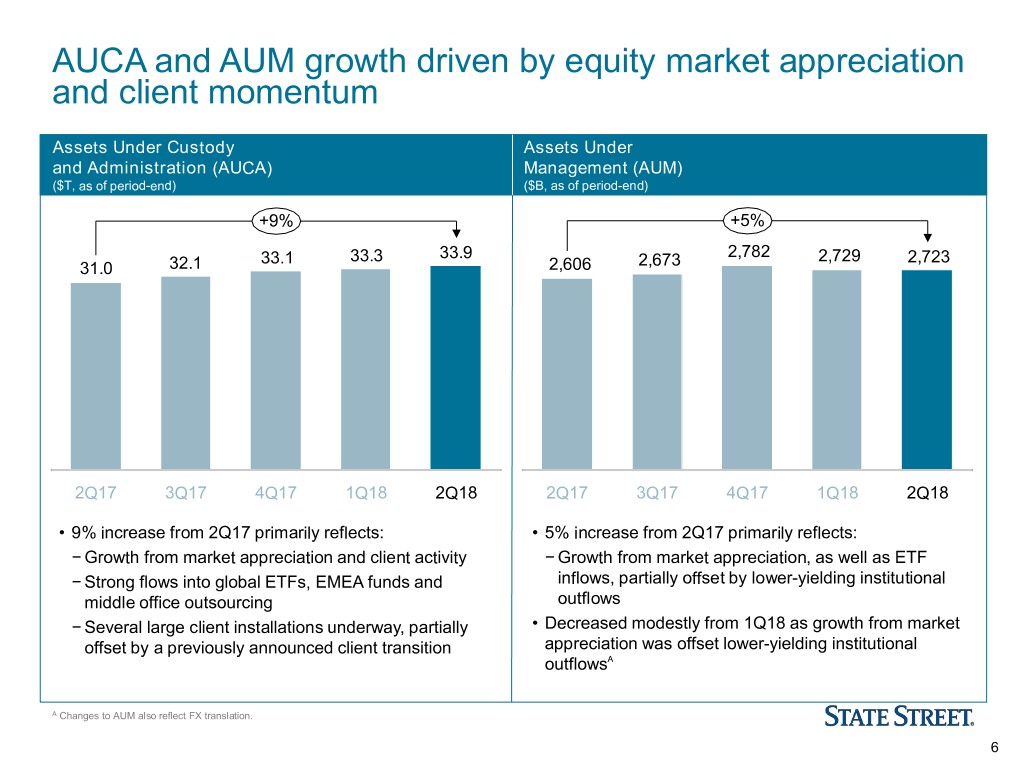
AUCA and AUM growth driven by equity market appreciation and client momentum Assets Under Custody Assets Under and Administration (AUCA) Management (AUM) ($T, as of period-end) ($B, as of period-end) +9% +5% 33.1 33.3 33.9 2,673 2,782 2,729 2,723 31.0 32.1 2,606 2Q17 3Q17 4Q17 1Q18 2Q18 2Q17 3Q17 4Q17 1Q18 2Q18 • 9% increase from 2Q17 primarily reflects: • 5% increase from 2Q17 primarily reflects: − Growth from market appreciation and client activity − Growth from market appreciation, as well as ETF − Strong flows into global ETFs, EMEA funds and inflows, partially offset by lower-yielding institutional middle office outsourcing outflows − Several large client installations underway, partially • Decreased modestly from 1Q18 as growth from market offset by a previously announced client transition appreciation was offset lower-yielding institutional outflowsA A Changes to AUM also reflect FX translation. 6

Fee revenue growth driven by equity market appreciation, new business and client activity Fee Revenue ($M) 2Q18 vs 2Q17 +6% Solid fee revenue growth of 6% +5% ex FX YoY • Servicing fees increased mainly due to higher equity 2,378 2,358 % ∆ 2,235 2,242 2,230 market levels, client activity and new business • Management feesA increased primarily driven by higher equity market levels and the adoption of the new revenue 1,381 3% 1,339 recognition accounting standard • Trading servicesA increased largely driven by higher FX client volumes 397 465 17% • Securities finance decreased primarily driven by lower seasonal activity 289 315 9% (14)% • Processing fees and other increased largely reflecting 179 154 31 43 39% lower amortization related to tax-advantaged investment activity and higher software fees 2Q17 3Q17 4Q17 1Q18 2Q18 • Favorable currency translation positively impacted Total fee revenue by $22M Servicing fees Management fees Trading services Securities finance revenue Processing fees and other A Effects of the new revenue recognition standard (ASU 2014-09) increased 2Q18 Total fee revenue by ~$70M. The revenue impact was ~$45M in Management fees, ~$20M A in Trading services, and ~$5M across other revenue line items. 7
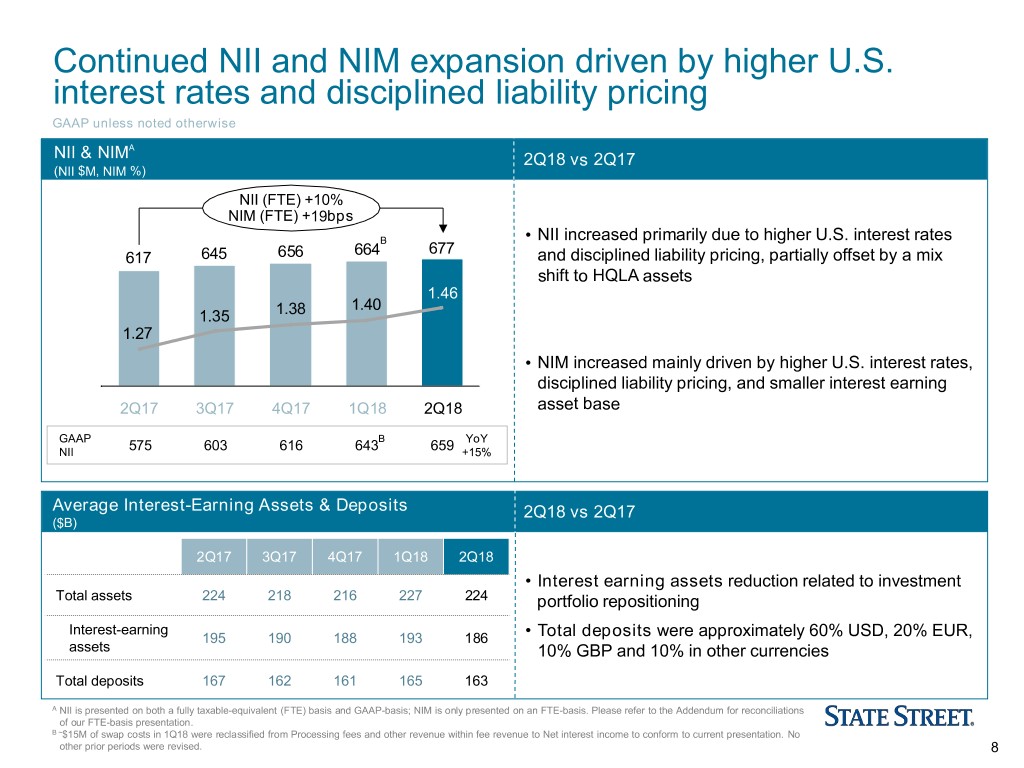
Continued NII and NIM expansion driven by higher U.S. interest rates and disciplined liability pricing GAAP unless noted otherwise A NII & NIM 2Q18 vs 2Q17 (NII $M, NIM %) NII (FTE) +10% NIM (FTE) +19bps B • NII increased primarily due to higher U.S. interest rates 664 677 617 645 656 and disciplined liability pricing, partially offset by a mix shift to HQLA assets 1.46 1.40 1.35 1.38 1.27 • NIM increased mainly driven by higher U.S. interest rates, disciplined liability pricing, and smaller interest earning 2Q17 3Q17 4Q17 1Q18 2Q18 asset base GAAP B YoY 575 603 616 643 659 NII +15% Average Interest-Earning Assets & Deposits 2 Q18 vs 2Q17 ($B) 2Q17 3Q17 4Q17 1Q18 2Q18 • Interest earning assets reduction related to investment Total assets 224 218 216 227 224 portfolio repositioning Interest-earning 195 190 188 193 186 • Total deposits were approximately 60% USD, 20% EUR, assets 10% GBP and 10% in other currencies Total deposits 167 162 161 165 163 A NII is presented on both a fully taxable-equivalent (FTE) basis and GAAP-basis; NIM is only presented on an FTE-basis. Please refer to the Addendum for reconciliations A of our FTE-basis presentation. B ~$15M of swap costs in 1Q18 were reclassified from Processing fees and other revenue within fee revenue to Net interest income to conform to current presentation. No B other prior periods were revised. 8

Expense growth reflects continued investments in the future while reducing legacy costs Expenses ($M) 2Q18 vs 2Q17 +6%A +5% ex FX Active expense management calibrated to the current B 2,256 C YoY revenue environment 2,131 2,159 % ∆ 2,031 2,021 • Compensation and employee benefitsC decreased primarily driven by: 1,155 1,249 1,125 (1)% − Savings from Beacon and lower performance-based 1,131 1,114 incentive compensation − Partially offset by costs to support new business and 315 321 13% 285 296 322 annual merit increases 242 246 19% 207 215 219 • Information systems and communications increased 141 120 124 7% 116 9 127 mainly due to Beacon-related investments and costs to 283 269 294 330 343 21% support new business 2Q17 3Q17 4Q17 1Q18 2Q18 • Transaction processingB increased primarily reflecting C,D Restructuring and repositioning costs higher client volumes and market levels 62 33 133 - 77 • OccupancyC increased largely reflecting repositioning charge • Unfavorable currency translation negatively impacted • OtherB increased mainly due to the adoption of the new Total expenses by $21M revenue recognition accounting standard • 2Q18 includes $77M of repositioning charge related to organizational realignment and management delayeringC Compensation and Information systems Transaction Occupancy Acquisition Costs Other employee benefits and communications processing A Effects of the new revenue recognition standard (ASU 2014-09) increased 2Q18 Total expenses by ~$70M. The expense impact was ~$15M in Transaction processing, A ~$45M in Other expenses, and ~$10M across other expense line items. B 1Q18 included $148M of seasonal deferred incentive compensation expense for retirement-eligible employees and payroll taxes. C 2Q18 repositioning charge of $77M is reflected in Compensation and employee benefits ($61M) and Occupancy ($16M) within our financial statements included C in the Addendum. D Restructuring charges in 2Q17, 3Q17 and 4Q17 have been allocated to individual expense lines for illustrative purposes in this presentation to align with the presentation of 9 D repositioning charge in 2Q18. Please refer to endnote 2 for additional details.
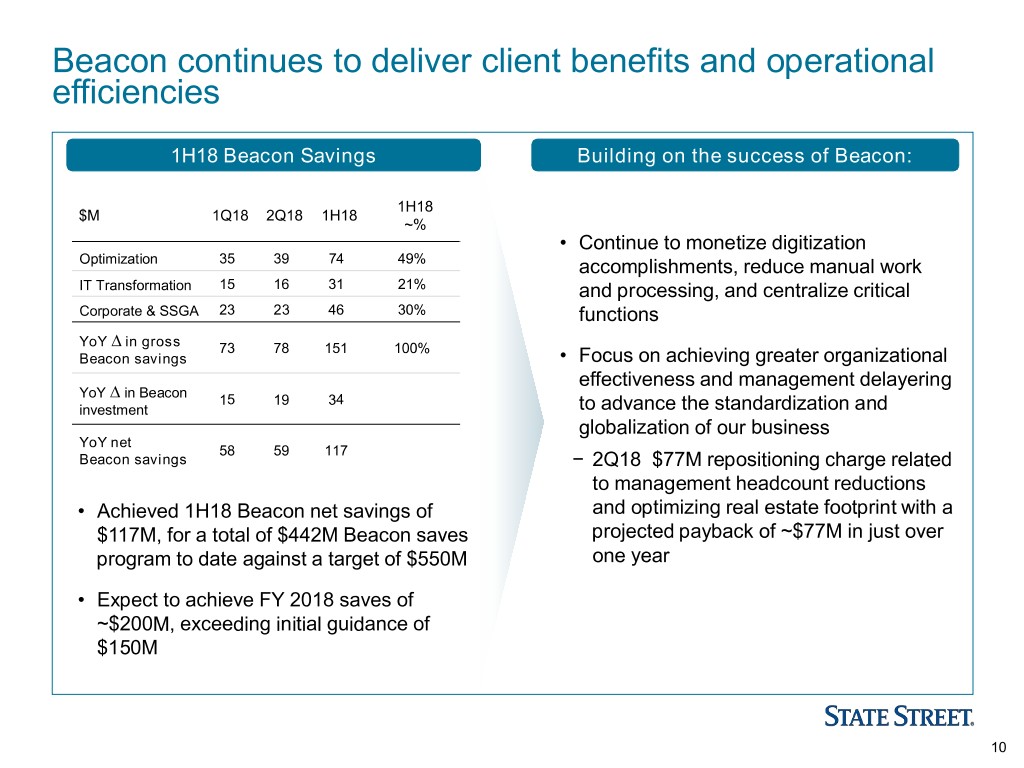
Beacon continues to deliver client benefits and operational efficiencies 1H18 Beacon Savings Building on the success of Beacon: 1H18 $M 1Q18 2Q18 1H18 ~% • Continue to monetize digitization Optimization 35 39 74 49% accomplishments, reduce manual work IT Transformation 15 16 31 21% and processing, and centralize critical Corporate & SSGA 23 23 46 30% functions YoY ∆ in gross 73 78 151 100% Beacon savings • Focus on achieving greater organizational effectiveness and management delayering YoY ∆ in Beacon 15 19 34 investment to advance the standardization and globalization of our business YoY net 58 59 117 Beacon savings − 2Q18 $77M repositioning charge related to management headcount reductions • Achieved 1H18 Beacon net savings of and optimizing real estate footprint with a $117M, for a total of $442M Beacon saves projected payback of ~$77M in just over program to date against a target of $550M one year • Expect to achieve FY 2018 saves of ~$200M, exceeding initial guidance of $150M 10

Investment portfolio and capital position highlights Investment Portfolio Highlights Quarter-End Capital Positions ($B, as of June 30, 2018) (%, Fully phased-in as of period-end) Capital Ratios 3,4,5,6 12.3% 12.0% 12.1% 12.4% $97.5B 11.7% $87.1B $85.6B 11.3% 11.6% 11.3% 10.9% 10.8% Non- Non- Non- Non- 7.3% HQLA Non- HQLA 6.9% 7.2% 6.9% 7.1% HQLA HQLA 39% HQLA 24% 24% 30% 30% 6.1% 6.4% 6.4% 6.0% 6.2% HQLA HQLA HQLA HQLA HQLA 76% 61% 70% 70% 76% 2Q17 3Q17 4Q17 1Q18 2Q18 Tier 1 Leverage SLR Standardized CET1 Advanced CET1 4Q17 1Q18 2Q18 CCAR 2018: Received non-objection to capital plan • Duration: 3.2 years in 2Q18 • 12% increase in dividend to $0.47 per quarter, beginning • Interest-rate risk metric: 3Q18; $1.2B share buyback program approved − In a hypothetical +100bps shock to quarter-end spot • Charles River Development acquisition incorporated interest rates, the unrealized after-tax available-for-sale based on equity neutral financing, including buyback mark-to-market (MTM) loss sensitivity is ~($1.2B) suspension and common and preferred stock issuance Refer to the Appendix included with this presentation for endnotes 1 to 6. 11
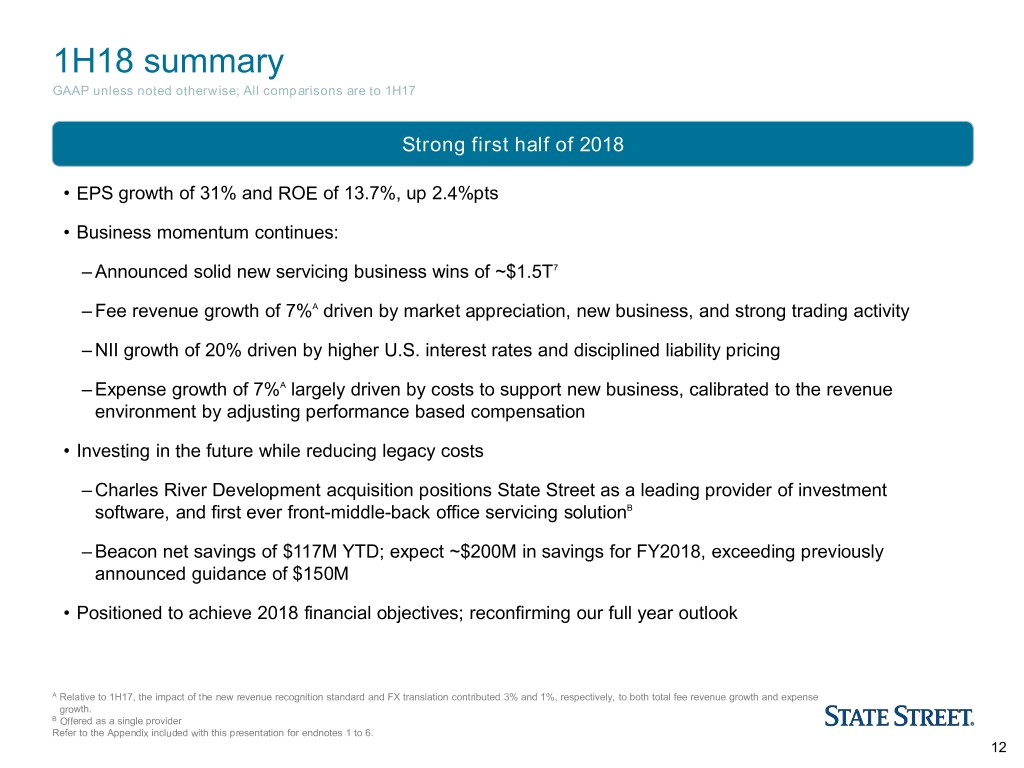
1H18 summary GAAP unless noted otherwise; All comparisons are to 1H17 Strong first half of 2018 • EPS growth of 31% and ROE of 13.7%, up 2.4%pts • Business momentum continues: – Announced solid new servicing business wins of ~$1.5T7 – Fee revenue growth of 7%A driven by market appreciation, new business, and strong trading activity – NII growth of 20% driven by higher U.S. interest rates and disciplined liability pricing – Expense growth of 7%A largely driven by costs to support new business, calibrated to the revenue environment by adjusting performance based compensation • Investing in the future while reducing legacy costs – Charles River Development acquisition positions State Street as a leading provider of investment B software, and first ever front-middle-back office servicing solution – Beacon net savings of $117M YTD; expect ~$200M in savings for FY2018, exceeding previously announced guidance of $150M • Positioned to achieve 2018 financial objectives; reconfirming our full year outlook A Relative to 1H17, the impact of the new revenue recognition standard and FX translation contributed 3% and 1%, respectively, to both total fee revenue growth and expense A growth. B Offered as a single provider Refer to the Appendix included with this presentation for endnotes 1 to 6. 12
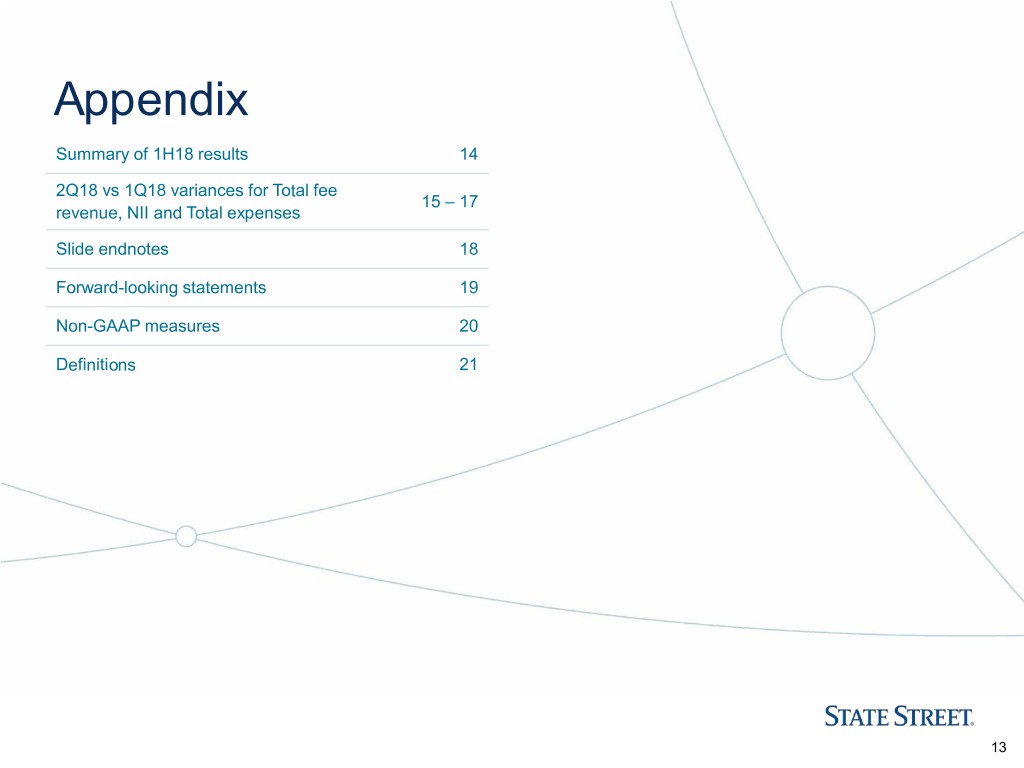
Appendix Summary of 1H18 results 14 2Q18 vs 1Q18 variances for Total fee 15 – 17 revenue, NII and Total expenses Slide endnotes 18 Forward-looking statements 19 Non-GAAP measures 20 Definitions 21 13
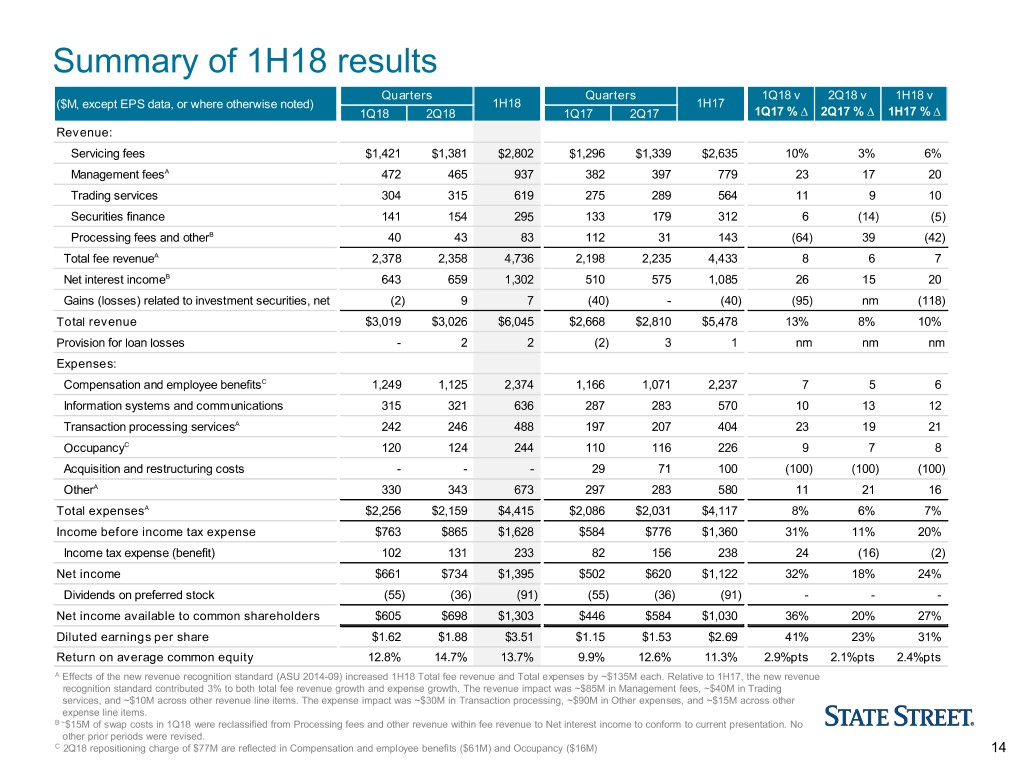
Summary of 1H18 results Quarters Quarters 1Q18 v 2Q18 v 1H18 v ($M, except EPS data, or where otherwise noted) 1H18 1H17 1Q18 2Q18 1Q17 2Q17 1Q17 % ∆ 2Q17 % ∆ 1H17 % ∆ Revenue: Servicing fees $1,421 $1,381 $2,802 $1,296 $1,339 $2,635 10% 3% 6% Management feesA 472 465 937 382 397 779 23 17 20 Trading services 304 315 619 275 289 564 11 9 10 Securities finance 141 154 295 133 179 312 6 (14) (5) Processing fees and otherB 40 43 83 112 31 143 (64) 39 (42) Total fee revenueA 2,378 2,358 4,736 2,198 2,235 4,433 8 6 7 Net interest incomeB 643 659 1,302 510 575 1,085 26 15 20 Gains (losses) related to investment securities, net (2) 9 7 (40) - (40) (95) nm (118) Total revenue $3,019 $3,026 $6,045 $2,668 $2,810 $5,478 13% 8% 10% Provision for loan losses - 2 2 (2) 3 1 nm nm nm Expenses: Compensation and employee benefitsC 1,249 1,125 2,374 1,166 1,071 2,237 7 5 6 Information systems and communications 315 321 636 287 283 570 10 13 12 Transaction processing servicesA 242 246 488 197 207 404 23 19 21 OccupancyC 120 124 244 110 116 226 9 7 8 Acquisition and restructuring costs - - - 29 71 100 (100) (100) (100) OtherA 330 343 673 297 283 580 11 21 16 Total expensesA $2,256 $2,159 $4,415 $2,086 $2,031 $4,117 8% 6% 7% Income before income tax expense $763 $865 $1,628 $584 $776 $1,360 31% 11% 20% Income tax expense (benefit) 102 131 233 82 156 238 24 (16) (2) Net income $661 $734 $1,395 $502 $620 $1,122 32% 18% 24% Dividends on preferred stock (55) (36) (91) (55) (36) (91) - - - Net income available to common shareholders $605 $698 $1,303 $446 $584 $1,030 36% 20% 27% Diluted earnings per share $1.62 $1.88 $3.51 $1.15 $1.53 $2.69 41% 23% 31% Return on average common equity 12.8% 14.7% 13.7% 9.9% 12.6% 11.3% 2.9%pts 2.1%pts 2.4%pts A Effects of the new revenue recognition standard (ASU 2014-09) increased 1H18 Total fee revenue and Total expenses by ~$135M each. Relative to 1H17, the new revenue A recognition standard contributed 3% to both total fee revenue growth and expense growth. The revenue impact was ~$85M in Management fees, ~$40M in Trading A services, and ~$10M across other revenue line items. The expense impact was ~$30M in Transaction processing, ~$90M in Other expenses, and ~$15M across other A expense line items. B ~$15M of swap costs in 1Q18 were reclassified from Processing fees and other revenue within fee revenue to Net interest income to conform to current presentation. No B other prior periods were revised. C 2Q18 repositioning charge of $77M are reflected in Compensation and employee benefits ($61M) and Occupancy ($16M) 14
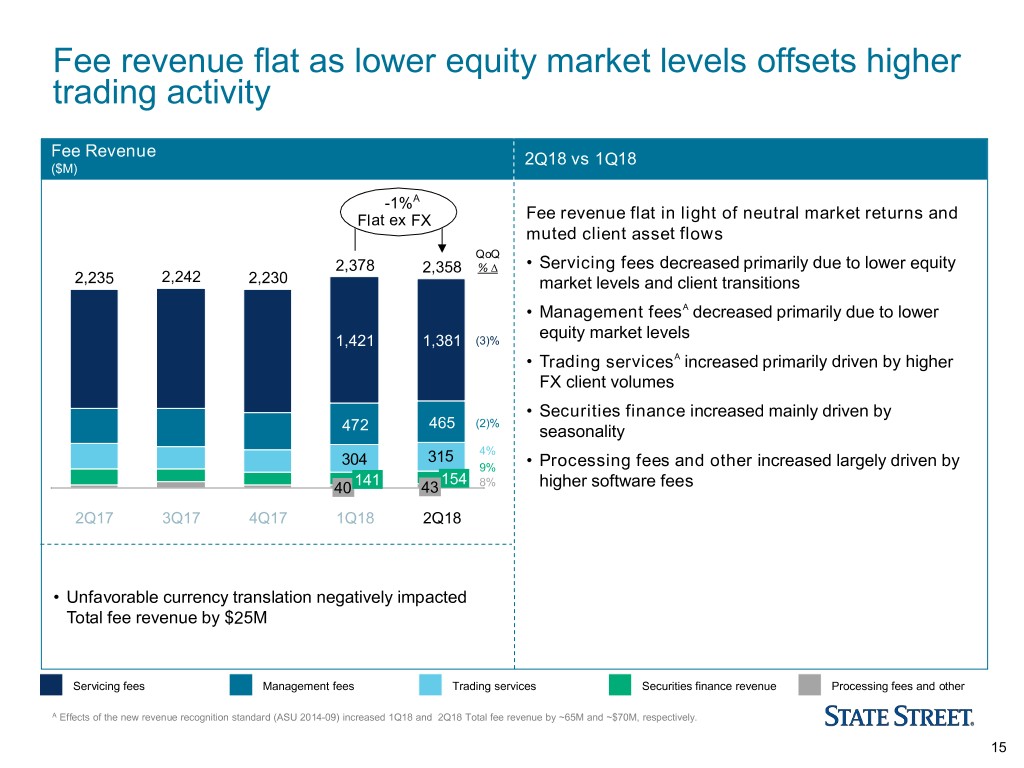
Fee revenue flat as lower equity market levels offsets higher trading activity Fee Revenue ($M) 2Q18 vs 1Q18 -1% A Flat ex FX Fee revenue flat in light of neutral market returns and muted client asset flows QoQ 2,378 2,358 % ∆ • Servicing fees decreased primarily due to lower equity 2,235 2,242 2,230 market levels and client transitions • Management feesA decreased primarily due to lower equity market levels 1,421 1,381 (3)% • Trading servicesA increased primarily driven by higher FX client volumes • Securities finance increased mainly driven by 465 (2)% 472 seasonality 315 4% 304 9% • Processing fees and other increased largely driven by 141 154 8% 40 43 higher software fees 2Q17 3Q17 4Q17 1Q18 2Q18 • Unfavorable currency translation negatively impacted Total fee revenue by $25M Servicing fees Management fees Trading services Securities finance revenue Processing fees and other A Effects of the new revenue recognition standard (ASU 2014-09) increased 1Q18 and 2Q18 Total fee revenue by ~65M and ~$70M, respectively. 15

Continued NII and NIM growth driven by higher U.S. interest rates and disciplined liability pricing GAAP unless noted otherwise A NII & NIM 2Q18 vs 1Q18 (NII $M, NIM %) NII (FTE) +2% NIM (FTE) +6bps • NII increased primarily due to higher U.S. interest rates B 645 656 664 677 and disciplined liability pricing, partially offset by a shift to 617 HQLA assets 1.46 1.40 1.35 1.38 1.27 • NIM increased driven by higher U.S. interest rates, disciplined liability pricing, and smaller balance sheet 2Q17 3Q17 4Q17 1Q18 2Q18 GAAP B QoQ 575 603 616 643 659 NII +2% Average Interest-Earning Assets & Deposits 2Q18 vs 1Q18 ($B) 2Q17 3Q17 4Q17 1Q18 2Q18 Total assets 224 218 216 227 224 • Interest earning assets reduction driven by investment portfolio repositioning Interest-earning 195 190 188 193 186 • Total deposits were approximately 60% USD, 20% EUR, assets 10% GBP and 10% in other currencies Total deposits 167 162 161 165 163 A NII is presented on both a fully taxable-equivalent (FTE) basis and GAAP-basis; NIM is only presented on an FTE-basis. Please refer to the Addendum for reconciliations A of our FTE-basis presentation. B ~$15M of swap costs in 1Q18 were reclassified from Processing fees and other revenue within fee revenue to Net interest income to conform to current presentation. No B other prior periods were revised. 16

Decline in expenses driven by lower incentive compensation offset by repositioning charge Expenses ($M) 2Q18 vs 1Q18 -4% A -3% ex FX Active expense management [resulted in modestly B QoQ lower underlying expenses] 2,256 C 2,131 2,159 % ∆ A 2,031 2,021 • Compensation and employee benefits decreased primarily due to lower incentive compensation and savings from Beacon, partially offset by repositioning 1,249 1,125 (10)% 1,131 1,114 1,155 charge • Information systems and communications increased 321 2% 285 296 322 315 mainly due to Beacon-related investments 246 2% A 207 215 219 242 • Occupancy increased primarily reflecting repositioning 116 141 120 124 3% 9 127 charge partially offset by the right-sizing of the real estate 283 269 294 330 343 4% footprint 2Q17 3Q17 4Q17 1Q18 2Q18 A • Other increased largely reflecting higher Beacon-related D Restructuring and repositioning costs investments and regulatory costs 62 33 133 - 77 • Favorable currency translation positively impacted Total expenses by $24M • 2Q18 includes $77M of repositioning charge related to organizational realignment and management delayeringC Compensation and Information systems Transaction Occupancy Acquisition costs Other employee benefits and communications processing A Effects of the new revenue recognition standard (ASU 2014-09) increased 2Q18 Total expenses by ~$70M. The expense impact was ~$15M in Transaction processing, A ~$45M in Other expenses, and ~$10M across other expense line items. B 1Q18 included $148M of seasonal deferred incentive compensation expense for retirement-eligible employees and payroll taxes. C 2Q18 repositioning charges of $77M are reflected in Compensation and employee benefits ($61M) and Occupancy ($16M) within our financial statements included C in the Addendum. D Restructuring charges in 2Q17, 3Q17 and 4Q17 have been allocated to individual expense lines for illustrative purposes in this presentation to align with the presentation of 17 D repositioning charges in 2Q18. Please refer to endnote 2 for additional details.

Slide endnotes 1 These amounts exclude new business which has been contracted, but for which the client has not yet provided permission to publicly disclose and for which the installation date extends beyond one quarter. 2 2Q17 restructuring charges of $62M have been allocated to compensation and employee benefits ($60M) and information systems and communications ($2M). 3Q17 restructuring charges of $33M have been allocated to compensation and employee benefits ($24M) and occupancy ($9M). 4Q17 restructuring charges of $133M have been allocated to compensation and employee benefits ($88M), information systems and communications ($21M) and occupancy ($24M). 3 Unless otherwise noted, all capital ratios referenced on this slide and elsewhere in this presentation refer to State Street Corporation, or State Street, and not State Street Bank and Trust Company, or State Street Bank. The lower of capital ratios calculated under the Basel III advanced approaches and under the Basel III standardized approach are applied in the assessment of our capital adequacy for regulatory purposes. Refer to the addendum included with this presentation for a further description of these ratios and for reconciliations applicable to State Street’s fully phased-in Basel III ratios. June 30, 2018 capital ratios are presented as of quarter-end and are preliminary estimates. 4 The advanced approaches-based ratios (actual and estimated) included in this presentation reflect calculations and determinations with respect to our capital and related matters, based on State Street and external data, quantitative formulae, statistical models, historical correlations and assumptions, collectively referred to as “advanced systems.” Refer to the addendum included with this presentation for a description of the advanced approaches and a discussion of related risks. Effective January 1, 2018, the applicable final rules are in effect and the ratios presented are calculated based on fully phased-in CET1, Tier 1 and total capital numbers. 5 Estimated pro-forma fully phased-in ratios as of June 30, 2017, September 30, 2017, and December 31, 2017 reflect capital and total risk-weighted assets calculated under the Basel III final rule. Refer to the addendum included with this presentation for reconciliations of these estimated pro-forma fully phased-in ratios to our capital ratios calculated under the then applicable regulatory requirements. Effective January 1, 2018, the applicable final rules are in effect and the ratios presented are calculated based on fully phased-in CET1, Tier 1 and total capital numbers. 6 Estimated pro-forma fully phased-in SLRs as of June 30, 2017, September 30, 2017, and December 31, 2017 (fully phased-in as of January 1, 2018, as per the phase-in requirements of the SLR final rule) are preliminary estimates as calculated under the SLR final rule. Refer to the addendum included with this presentation for reconciliations of these estimated pro-forma fully phased-in SLRs to our SLRs under the then applicable regulatory requirements. Effective January 1, 2018, the applicable final rules are in effect and the ratios presented are calculated based on fully phased-in CET1, Tier 1 and total capital numbers. 7 We expect that for the remainder of the year newly announced asset servicing mandates will return to levels more commonly reflected historically. New asset servicing mandates and servicing assets remaining to be installed in future periods exclude new business which has been contracted, but for which the client has not yet provided permission to publicly disclose and is not yet installed. These excluded assets, which from time to time may be significant, will be included in new asset servicing mandates and reflected in servicing assets remaining to be installed in the period in which the client provides its permission. Newly announced servicing asset mandates for the first quarter for 2018 include a significant amount of assets contracted for in the fourth quarter of 2017 for which we received client consent to disclose in the first quarter of 2018. Servicing mandates and servicing assets remaining to be installed in future periods are presented on a gross basis and therefore also do not include the impact of clients who have notified us during the period of their intent to terminate or reduce their relationship with State Street. 18
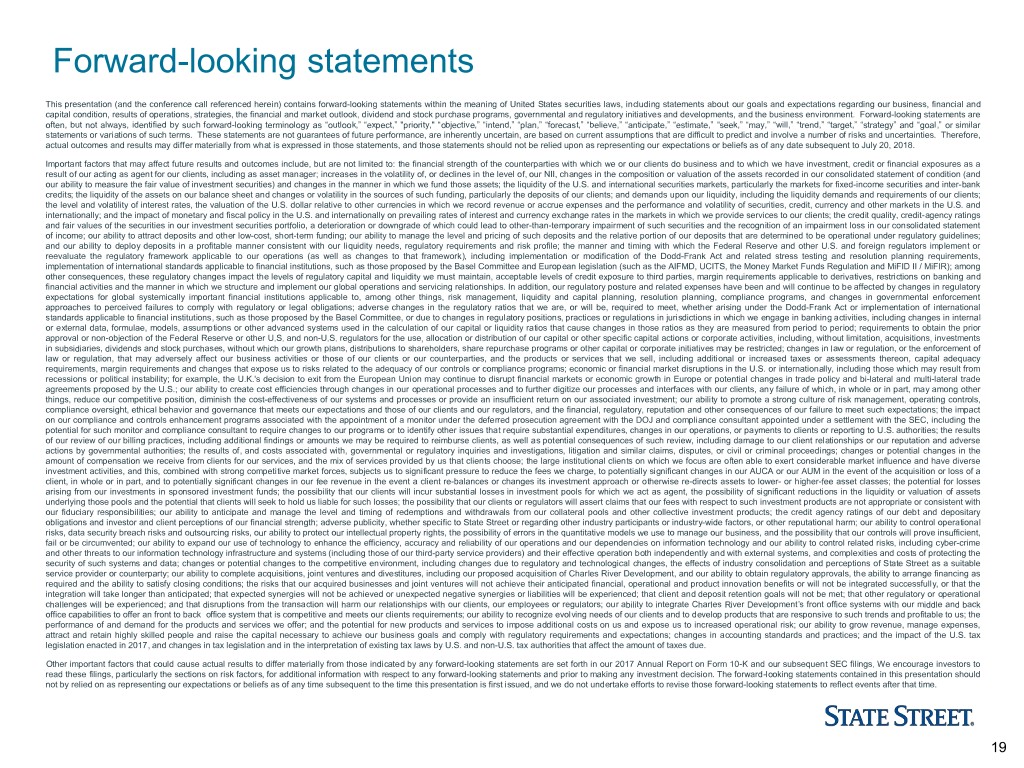
Forward-looking statements This presentation (and the conference call referenced herein) contains forward-looking statements within the meaning of United States securities laws, including statements about our goals and expectations regarding our business, financial and capital condition, results of operations, strategies, the financial and market outlook, dividend and stock purchase programs, governmental and regulatory initiatives and developments, and the business environment. Forward-looking statements are often, but not always, identified by such forward-looking terminology as “outlook,” “expect,” "priority," “objective,” “intend,” “plan,” “forecast,” “believe,” “anticipate,” “estimate,” “seek,” “may,” “will,” “trend,” “target,” “strategy” and “goal,” or similar statements or variations of such terms. These statements are not guarantees of future performance, are inherently uncertain, are based on current assumptions that are difficult to predict and involve a number of risks and uncertainties. Therefore, actual outcomes and results may differ materially from what is expressed in those statements, and those statements should not be relied upon as representing our expectations or beliefs as of any date subsequent to July 20, 2018. Important factors that may affect future results and outcomes include, but are not limited to: the financial strength of the counterparties with which we or our clients do business and to which we have investment, credit or financial exposures as a result of our acting as agent for our clients, including as asset manager; increases in the volatility of, or declines in the level of, our NII, changes in the composition or valuation of the assets recorded in our consolidated statement of condition (and our ability to measure the fair value of investment securities) and changes in the manner in which we fund those assets; the liquidity of the U.S. and international securities markets, particularly the markets for fixed-income securities and inter-bank credits; the liquidity of the assets on our balance sheet and changes or volatility in the sources of such funding, particularly the deposits of our clients; and demands upon our liquidity, including the liquidity demands and requirements of our clients; the level and volatility of interest rates, the valuation of the U.S. dollar relative to other currencies in which we record revenue or accrue expenses and the performance and volatility of securities, credit, currency and other markets in the U.S. and internationally; and the impact of monetary and fiscal policy in the U.S. and internationally on prevailing rates of interest and currency exchange rates in the markets in which we provide services to our clients; the credit quality, credit-agency ratings and fair values of the securities in our investment securities portfolio, a deterioration or downgrade of which could lead to other-than-temporary impairment of such securities and the recognition of an impairment loss in our consolidated statement of income; our ability to attract deposits and other low-cost, short-term funding; our ability to manage the level and pricing of such deposits and the relative portion of our deposits that are determined to be operational under regulatory guidelines; and our ability to deploy deposits in a profitable manner consistent with our liquidity needs, regulatory requirements and risk profile; the manner and timing with which the Federal Reserve and other U.S. and foreign regulators implement or reevaluate the regulatory framework applicable to our operations (as well as changes to that framework), including implementation or modification of the Dodd-Frank Act and related stress testing and resolution planning requirements, implementation of international standards applicable to financial institutions, such as those proposed by the Basel Committee and European legislation (such as the AIFMD, UCITS, the Money Market Funds Regulation and MiFID II / MiFIR); among other consequences, these regulatory changes impact the levels of regulatory capital and liquidity we must maintain, acceptable levels of credit exposure to third parties, margin requirements applicable to derivatives, restrictions on banking and financial activities and the manner in which we structure and implement our global operations and servicing relationships. In addition, our regulatory posture and related expenses have been and will continue to be affected by changes in regulatory expectations for global systemically important financial institutions applicable to, among other things, risk management, liquidity and capital planning, resolution planning, compliance programs, and changes in governmental enforcement approaches to perceived failures to comply with regulatory or legal obligations; adverse changes in the regulatory ratios that we are, or will be, required to meet, whether arising under the Dodd-Frank Act or implementation of international standards applicable to financial institutions, such as those proposed by the Basel Committee, or due to changes in regulatory positions, practices or regulations in jurisdictions in which we engage in banking activities, including changes in internal or external data, formulae, models, assumptions or other advanced systems used in the calculation of our capital or liquidity ratios that cause changes in those ratios as they are measured from period to period; requirements to obtain the prior approval or non-objection of the Federal Reserve or other U.S. and non-U.S. regulators for the use, allocation or distribution of our capital or other specific capital actions or corporate activities, including, without limitation, acquisitions, investments in subsidiaries, dividends and stock purchases, without which our growth plans, distributions to shareholders, share repurchase programs or other capital or corporate initiatives may be restricted; changes in law or regulation, or the enforcement of law or regulation, that may adversely affect our business activities or those of our clients or our counterparties, and the products or services that we sell, including additional or increased taxes or assessments thereon, capital adequacy requirements, margin requirements and changes that expose us to risks related to the adequacy of our controls or compliance programs; economic or financial market disruptions in the U.S. or internationally, including those which may result from recessions or political instability; for example, the U.K.'s decision to exit from the European Union may continue to disrupt financial markets or economic growth in Europe or potential changes in trade policy and bi-lateral and multi-lateral trade agreements proposed by the U.S.; our ability to create cost efficiencies through changes in our operational processes and to further digitize our processes and interfaces with our clients, any failure of which, in whole or in part, may among other things, reduce our competitive position, diminish the cost-effectiveness of our systems and processes or provide an insufficient return on our associated investment; our ability to promote a strong culture of risk management, operating controls, compliance oversight, ethical behavior and governance that meets our expectations and those of our clients and our regulators, and the financial, regulatory, reputation and other consequences of our failure to meet such expectations; the impact on our compliance and controls enhancement programs associated with the appointment of a monitor under the deferred prosecution agreement with the DOJ and compliance consultant appointed under a settlement with the SEC, including the potential for such monitor and compliance consultant to require changes to our programs or to identify other issues that require substantial expenditures, changes in our operations, or payments to clients or reporting to U.S. authorities; the results of our review of our billing practices, including additional findings or amounts we may be required to reimburse clients, as well as potential consequences of such review, including damage to our client relationships or our reputation and adverse actions by governmental authorities; the results of, and costs associated with, governmental or regulatory inquiries and investigations, litigation and similar claims, disputes, or civil or criminal proceedings; changes or potential changes in the amount of compensation we receive from clients for our services, and the mix of services provided by us that clients choose; the large institutional clients on which we focus are often able to exert considerable market influence and have diverse investment activities, and this, combined with strong competitive market forces, subjects us to significant pressure to reduce the fees we charge, to potentially significant changes in our AUCA or our AUM in the event of the acquisition or loss of a client, in whole or in part, and to potentially significant changes in our fee revenue in the event a client re-balances or changes its investment approach or otherwise re-directs assets to lower- or higher-fee asset classes; the potential for losses arising from our investments in sponsored investment funds; the possibility that our clients will incur substantial losses in investment pools for which we act as agent, the possibility of significant reductions in the liquidity or valuation of assets underlying those pools and the potential that clients will seek to hold us liable for such losses; the possibility that our clients or regulators will assert claims that our fees with respect to such investment products are not appropriate or consistent with our fiduciary responsibilities; our ability to anticipate and manage the level and timing of redemptions and withdrawals from our collateral pools and other collective investment products; the credit agency ratings of our debt and depositary obligations and investor and client perceptions of our financial strength; adverse publicity, whether specific to State Street or regarding other industry participants or industry-wide factors, or other reputational harm; our ability to control operational risks, data security breach risks and outsourcing risks, our ability to protect our intellectual property rights, the possibility of errors in the quantitative models we use to manage our business, and the possibility that our controls will prove insufficient, fail or be circumvented; our ability to expand our use of technology to enhance the efficiency, accuracy and reliability of our operations and our dependencies on information technology and our ability to control related risks, including cyber-crime and other threats to our information technology infrastructure and systems (including those of our third-party service providers) and their effective operation both independently and with external systems, and complexities and costs of protecting the security of such systems and data; changes or potential changes to the competitive environment, including changes due to regulatory and technological changes, the effects of industry consolidation and perceptions of State Street as a suitable service provider or counterparty; our ability to complete acquisitions, joint ventures and divestitures, including our proposed acquisition of Charles River Development, and our ability to obtain regulatory approvals, the ability to arrange financing as required and the ability to satisfy closing conditions; the risks that our acquired businesses and joint ventures will not achieve their anticipated financial, operational and product innovation benefits or will not be integrated successfully, or that the integration will take longer than anticipated; that expected synergies will not be achieved or unexpected negative synergies or liabilities will be experienced; that client and deposit retention goals will not be met; that other regulatory or operational challenges will be experienced; and that disruptions from the transaction will harm our relationships with our clients, our employees or regulators; our ability to integrate Charles River Development’s front office systems with our middle and back office capabilities to offer an front to back office system that is competitive and meets our clients requirements; our ability to recognize evolving needs of our clients and to develop products that are responsive to such trends and profitable to us; the performance of and demand for the products and services we offer; and the potential for new products and services to impose additional costs on us and expose us to increased operational risk; our ability to grow revenue, manage expenses, attract and retain highly skilled people and raise the capital necessary to achieve our business goals and comply with regulatory requirements and expectations; changes in accounting standards and practices; and the impact of the U.S. tax legislation enacted in 2017, and changes in tax legislation and in the interpretation of existing tax laws by U.S. and non-U.S. tax authorities that affect the amount of taxes due. Other important factors that could cause actual results to differ materially from those indicated by any forward-looking statements are set forth in our 2017 Annual Report on Form 10-K and our subsequent SEC filings. We encourage investors to read these filings, particularly the sections on risk factors, for additional information with respect to any forward-looking statements and prior to making any investment decision. The forward-looking statements contained in this presentation should not by relied on as representing our expectations or beliefs as of any time subsequent to the time this presentation is first issued, and we do not undertake efforts to revise those forward-looking statements to reflect events after that time. 19
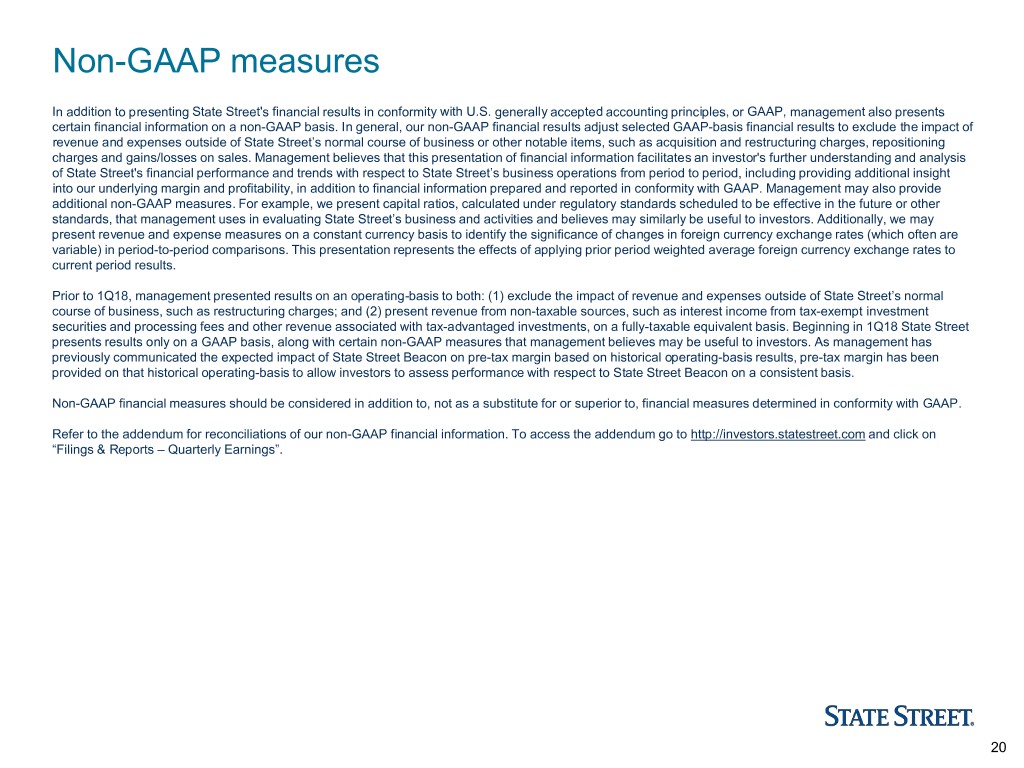
Non-GAAP measures In addition to presenting State Street's financial results in conformity with U.S. generally accepted accounting principles, or GAAP, management also presents certain financial information on a non-GAAP basis. In general, our non-GAAP financial results adjust selected GAAP-basis financial results to exclude the impact of revenue and expenses outside of State Street’s normal course of business or other notable items, such as acquisition and restructuring charges, repositioning charges and gains/losses on sales. Management believes that this presentation of financial information facilitates an investor's further understanding and analysis of State Street's financial performance and trends with respect to State Street’s business operations from period to period, including providing additional insight into our underlying margin and profitability, in addition to financial information prepared and reported in conformity with GAAP. Management may also provide additional non-GAAP measures. For example, we present capital ratios, calculated under regulatory standards scheduled to be effective in the future or other standards, that management uses in evaluating State Street’s business and activities and believes may similarly be useful to investors. Additionally, we may present revenue and expense measures on a constant currency basis to identify the significance of changes in foreign currency exchange rates (which often are variable) in period-to-period comparisons. This presentation represents the effects of applying prior period weighted average foreign currency exchange rates to current period results. Prior to 1Q18, management presented results on an operating-basis to both: (1) exclude the impact of revenue and expenses outside of State Street’s normal course of business, such as restructuring charges; and (2) present revenue from non-taxable sources, such as interest income from tax-exempt investment securities and processing fees and other revenue associated with tax-advantaged investments, on a fully-taxable equivalent basis. Beginning in 1Q18 State Street presents results only on a GAAP basis, along with certain non-GAAP measures that management believes may be useful to investors. As management has previously communicated the expected impact of State Street Beacon on pre-tax margin based on historical operating-basis results, pre-tax margin has been provided on that historical operating-basis to allow investors to assess performance with respect to State Street Beacon on a consistent basis. Non-GAAP financial measures should be considered in addition to, not as a substitute for or superior to, financial measures determined in conformity with GAAP. Refer to the addendum for reconciliations of our non-GAAP financial information. To access the addendum go to http://investors.statestreet.com and click on “Filings & Reports – Quarterly Earnings”. 20
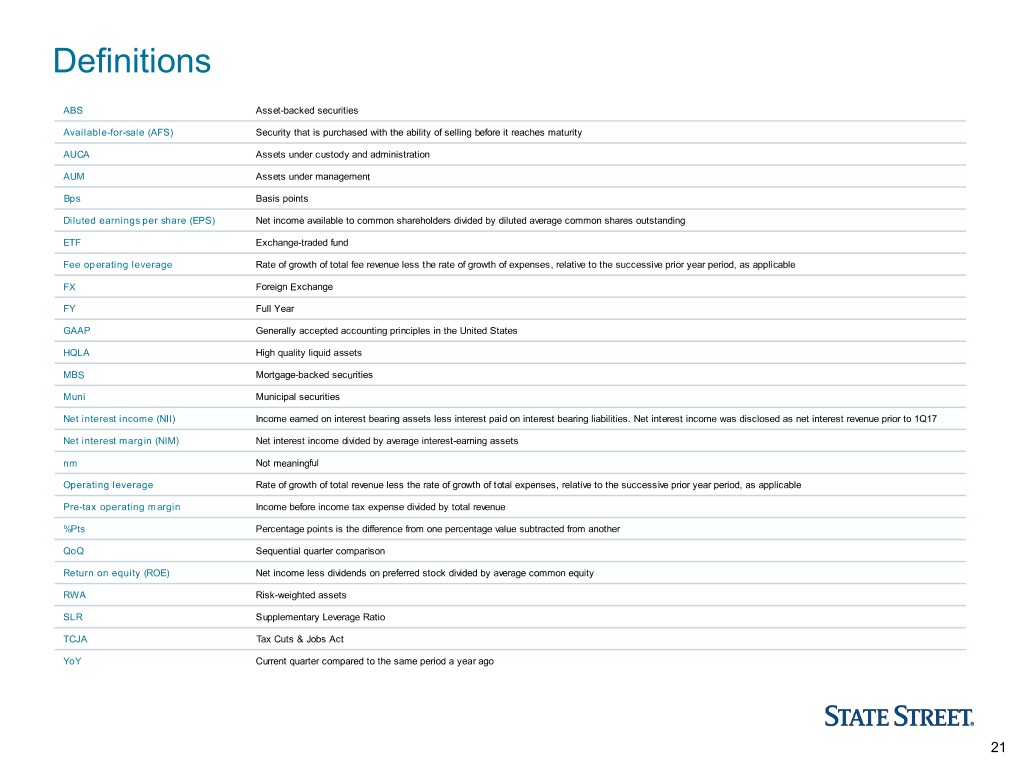
Definitions ABS Asset-backed securities Available-for-sale (AFS) Security that is purchased with the ability of selling before it reaches maturity AUCA Assets under custody and administration AUM Assets under management Bps Basis points Diluted earnings per share (EPS) Net income available to common shareholders divided by diluted average common shares outstanding ETF Exchange-traded fund Fee operating leverage Rate of growth of total fee revenue less the rate of growth of expenses, relative to the successive prior year period, as applicable FX Foreign Exchange FY Full Year GAAP Generally accepted accounting principles in the United States HQLA High quality liquid assets MBS Mortgage-backed securities Muni Municipal securities Net interest income (NII) Income earned on interest bearing assets less interest paid on interest bearing liabilities. Net interest income was disclosed as net interest revenue prior to 1Q17 Net interest margin (NIM) Net interest income divided by average interest-earning assets nm Not meaningful Operating leverage Rate of growth of total revenue less the rate of growth of total expenses, relative to the successive prior year period, as applicable Pre-tax operating margin Income before income tax expense divided by total revenue %P ts Percentage points is the difference from one percentage value subtracted from another QoQ Sequential quarter comparison Return on equity (ROE) Net income less dividends on preferred stock divided by average common equity RWA Risk-weighted assets SLR Supplementary Leverage Ratio TCJA Tax Cuts & Jobs Act YoY Current quarter compared to the same period a year ago 21
